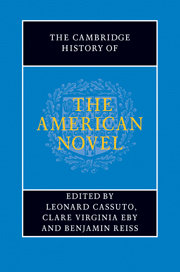Book contents
- Frontmatter
- General Introduction
- PART ONE INVENTING THE AMERICAN NOVEL
- PART TWO REALISM, PROTEST, ACCOMMODATION
- PART THREE MODERNISM AND BEYOND
- Introduction: modernism and beyond
- 37 Stein, Hemingway, and American modernisms
- 38 The Great Gatsby and the 1920s
- 39 Philosophy and the American novel
- 40 Steinbeck and the proletarian novel
- 41 The novel, mass culture, mass media
- 42 Wright, Hurston, and the direction of the African American novel
- 43 Ellison and Baldwin: aesthetics, activism, and the social order
- 44 Religion and the twentieth-century American novel
- 45 Faulkner and the Southern novel
- 46 Law and the American novel
- 47 Twentieth-century publishing and the rise of the paperback
- 48 The novel of crime, mystery, and suspense
- 49 US novels and US wars
- 50 Science fiction
- 51 Female genre fiction in the twentieth century
- 52 Children's novels
- 53 The American novel and the rise of the suburbs
- 54 The Jewish great American novel
- 55 The Beats and the 1960s
- 56 Literary feminisms
- 57 Reimagining genders and sexualities
- PART FOUR CONTEMPORARY FORMATIONS
- A selected bibliography
- Index
44 - Religion and the twentieth-century American novel
from PART THREE - MODERNISM AND BEYOND
Published online by Cambridge University Press: 28 July 2011
- Frontmatter
- General Introduction
- PART ONE INVENTING THE AMERICAN NOVEL
- PART TWO REALISM, PROTEST, ACCOMMODATION
- PART THREE MODERNISM AND BEYOND
- Introduction: modernism and beyond
- 37 Stein, Hemingway, and American modernisms
- 38 The Great Gatsby and the 1920s
- 39 Philosophy and the American novel
- 40 Steinbeck and the proletarian novel
- 41 The novel, mass culture, mass media
- 42 Wright, Hurston, and the direction of the African American novel
- 43 Ellison and Baldwin: aesthetics, activism, and the social order
- 44 Religion and the twentieth-century American novel
- 45 Faulkner and the Southern novel
- 46 Law and the American novel
- 47 Twentieth-century publishing and the rise of the paperback
- 48 The novel of crime, mystery, and suspense
- 49 US novels and US wars
- 50 Science fiction
- 51 Female genre fiction in the twentieth century
- 52 Children's novels
- 53 The American novel and the rise of the suburbs
- 54 The Jewish great American novel
- 55 The Beats and the 1960s
- 56 Literary feminisms
- 57 Reimagining genders and sexualities
- PART FOUR CONTEMPORARY FORMATIONS
- A selected bibliography
- Index
Summary
One of realism's founding fathers – Gustave Flaubert – proclaimed that “the artist in his work should be like God in the universe, present everywhere and visible nowhere.” Whatever god-like status turn-of-the-century American realists cherished with respect to their creations, the more mundane aspects of religion also appeared occasionally in their works. Religious practice was part of the landscape of social life that concerned novelists such as Theodore Dreiser, Edith Wharton, Henry James, and Sinclair Lewis. A signal – and early – example is Harold Frederic's The Damnation of Theron Ware (1896), which stands out for its dramatic focus on religious change at the end of the nineteenth century and for its simultaneous critique of and respect for the religious worlds embedded in American society. The Damnation of Theron Ware announces the continuing significance of the American novel's relationship with religious life and religious discourse throughout the twentieth century and into the twenty-first, even while it registers changes in emphasis – from Protestant to Catholic models of religious thought, from moral message to ritual form, from sectarian conviction to pluralist doubt, from catechism to mysticism.
The changes in emphasis on display in Theron Ware, already palpable in the early century, solidify into a dominant strand of American fiction after 1960. In that strand of fiction, religious thought entwines in new ways with the highest ambitions of literary art.
- Type
- Chapter
- Information
- The Cambridge History of the American Novel , pp. 732 - 749Publisher: Cambridge University PressPrint publication year: 2011
- 1
- Cited by



